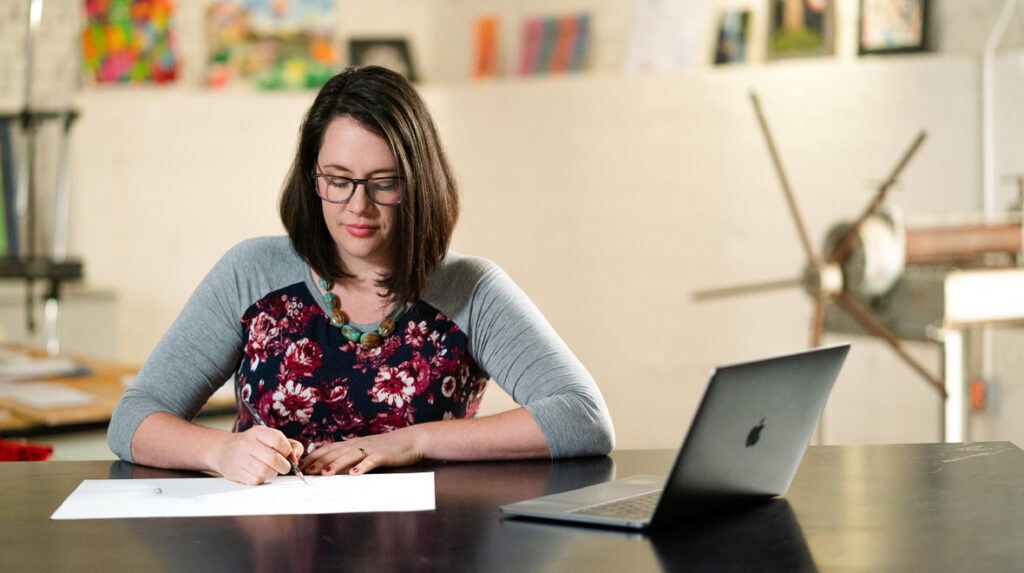Have you ever filled out a “quick application” to be considered for something? Maybe your car dealership requires a “quick application for approval,” or a side gig requests a “quick application for employment.” Then, you come to find out you need to submit sixteen personal and professional references, thirty-seven years of credit history, and a notarized copy of your middle school report card.
Applying to a graduate program shouldn’t be quick and easy, but it also shouldn’t feel like a thorn in your side. AOEU’s Master of Arts in Art Education is a rigorous and engaging program and we designed the application to reflect that.
Along the way, your Admissions Counselor will be there to support you as little or as much as you need. The application is both meaningful and reflective of your work as an art educator. Best of all, the application is designed to be user-friendly and easy to navigate. (And if you get stuck, we created some documents to support you!)
Follow the four tips below and you will have everything you need to put your best foot forward.

Tip 1: Prepare
Sure, preparation might go unsaid, but it’s critical in understanding the big picture. AOEU’s application is a multi-modal process, so preparing will help you put together a cohesive application submission. But, what does preparing actually look like?
Click through the online application.
You can see everything before you even get started, and you don’t even have to work through it in order! Take a few minutes to get acclimated with the application format and directions.
Determine what you already have.
Already have a classroom Instagram? You might have everything you need for the micro-portfolio. Just updated your resume? Look it over to ensure you’ve included your most recent experience and then check it off the list.
Set a series of small goals.
Applying might seem like a big goal to tackle all at once, but determining a topic for your writing sample is something you might be able to do between classes. Break down the goal of “applying” into several smaller tasks.
Start thinking broadly.
What are your goals? Why do you want to earn a master’s degree? What do you want your application to communicate about you? Our review team wants to understand you as a professional but we also want to see your personality! Don’t overthink things and be yourself!
Tip 2: Create a Timeline
When you work with your admissions counselor, they’ll ask you questions about your timeline for applying. This is the best way to determine your own due dates for the application process. Since you can apply at any time, it may be difficult to hold yourself accountable. Start by setting due dates for each small task you need to complete.
Use these questions to determine your application timeline.
Have you had your official transcripts sent to AOEU?
All institutions are different, so make sure you start early. Your official transcripts need to document an earned BA degree or higher. Electronic transcripts are sent almost instantly and should be reflected on your account within a few days. Mailed transcripts take a bit longer, generally between one to three weeks. Learn more about sending your transcripts here.
When do you want your application to be officially under review?
Once AOEU has your official transcripts and completed application, you’ll hear back from us within seven days.
When do you want to start your degree?
We recommend you get your application in by the 20th of the month prior to when you’d like to begin the program. So, if you want to start on June 1, plan to have your application and official transcripts in by May 20th.
When do you want to start taking courses?
You can begin an AOEU course before submitting your application. Actually, you can take a few! If you’re ready to jump in, take your courses for graduate credit and earn an 80% or higher. Then, if you are accepted to the program, up to eighteen previously completed AOEU credits automatically transfer into your degree.
Tip 3: Put Together the Major Components

The application has two major components. Let’s take a look at each.
- Writing Sample
The writing sample is the best opportunity for you to showcase your academic competency. It should be a professional and polished reflection that outlines why art education is important and why you want to earn a master’s degree. Support your thoughts with outside resources, personal examples, and details! - Micro-Portfolio
Art teachers are visual people. What better way to showcase yourself and your teaching than a collection of visuals? Consider a variety of images showing anything related to art or art education: student work, your own artwork, images of your classroom space, art displays, etc. Anything you might post on a classroom Instagram could be a good option! Write a short caption for each image so reviewers understand what they’re viewing.
Tip 4: Review Everything with a Critical Eye

Reviewing your application is the most important thing you can do. Before you press submit, ensure everything you’ve submitted shows you in the best light.
Use the 3 Ps as your guide to reviewing your application.
- Professional
Your application should be a professional representation of yourself. Your writing should be proofread and have no errors in spelling or grammar. The images in your micro-portfolio should be clear, well-lit, and have descriptive captions. In your video of intent, make sure you’ve shown confidence and clearly outlined your professional goals for wanting to earn your master’s degree through The Art of Education University. - Passionate
Art teachers are the best advocates. We’re constantly advocating for the arts, for our students, for our supply budgets, and more. Use your application as an opportunity to show what you’re really passionate about and what you advocate for. Consider it a platform where you advocate for your own professional learning, finding opportunities to convince application reviewers you are an excellent fit for AOEU’s program. - Personal
Use the application to showcase your personality and what makes you unique! Add a pop of your favorite color to your resume. Use the images in your micro-portfolio to tell your visual story as both artist and educator. I’ve said it before and I’ll say it again—be yourself!
Although applying to a master’s degree program can sound daunting, it doesn’t need to be. Use the helpful tips outlined here to guide you in the process. Don’t forget—you’ll have your Admissions Counselor there to help!
Are you thinking about applying? Use the buttons below to get started!
Contact an Admissions Counselor
Have you started your application to AOEU?
What questions do you have about the application process?
Magazine articles and podcasts are opinions of professional education contributors and do not necessarily represent the position of the Art of Education University (AOEU) or its academic offerings. Contributors use terms in the way they are most often talked about in the scope of their educational experiences.





